Summary
The energy output was enormous. It was able to smash concrete into fine dust. The smallest size of particles was 0.3 microns. Objects were thrown far from the hypocenter. Many objects simply vanished. Humans were vaporized–no remains of 1,116 can be found. Many similarities in WTC events and Hiroshima bombing:
- vaporization of objects 0.3 micron sized particles, furniture not found, not larger than a telephone dialing pad
- vaporization of human bodies
- no jewelery e.g. watches found
- mainly small-sized parts of body found such as bone fragments
- disappearance of objects
- only one filing cabinet found, should have been hundreds, if not a thousand
- pile of rubble very short, doesn’t fit with a pancake collapse
Similarities to volcanoes
- large output of dust—powderization phenomenon–landscape of lower Manhattan area same as after a volcano eruption—moonscape and fine dust everywhere
- not much concrete chunks left—mostly turned into powder (600,000 cubic tons of concrete per Twin Tower)
Energy Output
Directions of scattered materials
In a nuclear explosion, the size of the blast is so large that many materials are expelled far from the hypocenter, sometimes miles away. The map shows the distance that objects traveled from the hypocenter in the Hiroshima atomic bombing.

The remains of 40% of the victims at WTC have still not been found
“Fifteen years after the attacks on the World Trade Center, the remains of 1,113 victims — 40 percent of the 2,753 who died — still have not been identified.”
|
Still Missing: Unidentified Remains Leave a Lingering Void for 9/11 Families … That absence of physical evidence agonizes many 9/11 families. Some describe the missing identifications as equivalent to a great vanishing, similar to the thousands lost in the 2004 Indian Ocean tsunami, or the disappearances of political dissidents in Argentina’s Dirty War. The victims are undoubtedly dead, but there is no bodily proof …. Read more: NBC News |
Human remains found on rooftop of Deutsche Bank 130 Liberty Street (Bankers Trust Building)
700 human remains were found on the roof of Deutsche Bank (Banker’s Trust) building in 2006. These were mostly bone fragments. The small size of the remains suggests a blast force was present at the time of the collapse. Pancake collapses would not cause this kind of particularization of human bodies. As of 2013, only 1,634 people have been identified out of 2,750 people who died at the WTC, leaving 1,116 people still not identified. From the map below, the human remains were blown about 100 meters (200 feet) in horizontal distance to the roof top of the Deutsche Bank building at 130 Liberty Street if we assume the bodies came from the South Tower (WTC 2), the closest tower to the building.

Map of Banker’s Trust at 130 Liberty Street and the Twin Towers. WTC 2 (South Tower) is the closest to it and is about 200 feet in distance from it
“In September 2005 human remains were found on the roof.[4] In March 2006, construction workers who were removing toxic waste from the building before dismantling found more bone fragments and remains. This prompted calls from victims’ family members for another search of the building by forensic experts. Between April 7 and April 14, 2006, more than 700 human bone fragments were discovered in the ballast gravel on the roof. Workers sifted through the gravel to find more remains.” Wikipedia
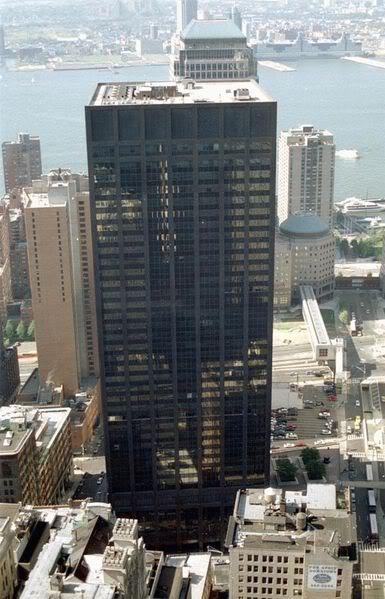
Banker’s Trust (Deutsche Bank) Image: Wikipedia

Deutsche Building (Banker’s Trust) stands to the right top with the red line pointing to it. Next to it is the shell of the WTC Twin Towers. Image: Wikipedia

An aerial view shows the Banker’s Trust building and the WTC site. (Googlemap)
Galvanized tin roofing

330m from the hypocenter
Fukuro-machi
This fell on the roof of Hiroshima Fukoku Building in Fukuro-machi. pcf.city.hiroshima.jp
Like the WTC event, objects were thrown quite a distance away, some of the objects were thrown several hundred meters away.
Melted lunch box and ivory pipe
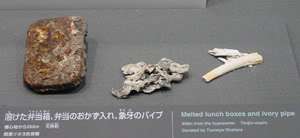
Donated by Tsuneyo Okahara
300m from the hypocenter
Tenjin-machi
“Masataro Okahara (then, 49) was exposed to the A-bomb in his office. His wife Tsuneyo immediately tried to get into the city to find him but was stopped by the ferocious flames. On the 9th, she began searching all the relief stations in the city. One week after the bombing, she dug into the ruins of Masataro’s workplace where his desk had been and found bones in the position of a person sitting in a chair. The lunch box and pipe lay at the end of the outstretched right arm. Stunned by this confirmation of her husband’s death, Tsuneyo sank to the ground.”
As in the September 11 attacks at the World Trade Center, this woman found only bones of her husband. Metal objects like the lunch box were melted by the intense heat.
Ten-yen bill (“Paper and Powder”)

Collected from where it fell in Jigozen Village, Saeki County (now, Hatsukaichi City), 14km west of the hypocenter.
In a nuclear explosion, objects without much mass can escape the thermal heat and can often be the only objects that are found in abundance, when objects with heavier mass have been burned or blasted into particles or shattered and twisted. This is the “paper and powder” phenomenon seen in atomic blasts.
Another ten-yen bill

Collected from where it fell in Tomo Village, Asa County (now Hiroshima City Asaminami Ward), 8.5 km from the hypocenter.
These small bits of paper found in the aftermath of the Hiroshima atomic bombing are similar to the debris left behind in the September 11 WTC attacks. Paper pieces fluttered about in the dust-covered streets like a paper snow-storm. Note the distance this piece of yen note traveled from the hypocenter (14 km).
Enough energy to snap 30-ton beams and toss them aside

Pieces of steel recovered from the World Trade Center site are preserved in Hangar 17 of Kennedy International Airport. Three are about 1,350 pieces of steel, many weighing over 30 tons (3,000 pounds). Apparently these were sheared off from the side of the building and snapped in the middle.
Notice the curved end of the beam. Heat of great temperatures bent the steel beam into a loop shape. Jet-fuel fires are unable to generate such high temperatures able to bend heavy steel beams (some as much as 3,000 pounds in weight) into pretzel shape configurations. However, the heat generated by an atomic blast is amply capable of doing just that.
Disappearance
Wooden sandal (Geta)

Donated by Tomiko Inoue
500m from the hypocenter
Zaimoku-cho(now Nakajima-cho)
Miyoko (then, 13) was a first-year student at First Municipal Girls High School. She was exposed to the bomb at her building demolition work site at Zaimoku-cho. Her body was never found, but her mother found this wooden sandal three months later. She recognized it by the straps she had made herself using material from her kimono.
The lack of remains is striking in WTC attacks. Like this girl, many families of the September 11 victims are unable to recover the bodies of their loved ones. In 2013, 1,116 people were still not able to be identified.
In the interview below, Patricia Ondrovic, a first responder who worked in the emergency services, gives an account of what she found in the rubble. What is remarkable is the lack of objects found in the rubble. In a pancake collapse of an office tower, you would be able to find many recognizable objects as an office tower would contain many pieces of furniture and office paraphernalia.
I personally never saw anything definable like a chair, desk, or phone
In Ondrovic’s case, she was not able to find any jewellery or other personal effects, nor intact whole bodies. Only a tooth or a body part or similar.
I remember cataloging findings in the morgue log — a tooth, an arm and such. Never catalogued watches, wallets or jewelry.
In a nuclear explosion, it would be normal not to find many intact objects as the blast force would smash objects, even large ones like a chair into particles or small pieces. One responder said he had difficulty finding any object larger than a telephone dialing pad.
I never came across any personal effects. The things I did find were charred, burnt, rubble covered in soot. I guess that’s the needle in the haystack [the ATM card].
Patricia Ondrovic – Lack of objects found in rubble
KT: What were your duties when you had to go back?
PO: We all took turns doing morgue detail, standby for anyone who got hurt going through the rubble. I did morgue detail a few times.
KT: Is this what is referred to as “bag & tag”?
PO: Yes, when you have to log any body parts, or personal effects in morgue work. It was important to try to document any remains we found.
KT: Now despite this being probably the most chaotic incident you had to work at, did you find any strange things when you’re recovering evidence there?
PO: Well, I remember cataloging findings in the morgue log — a tooth, an arm and such. Never catalogued watches, wallets or jewelry.
KT: You never found any jewelry on any of the victim’s parts?
PO: I didn’t, no. But I do recall at some point either in Brooklyn or Staten Island they had a facility where debris was trucked to and the contents sifted by hand for any evidence. That was some time after 9/11, maybe a few weeks after they started that.
KT: Did you find any personal belongings on the ground or buried under any debris?
PO: I didn’t.
KT: What about things like office furniture, computers, and pictures — things that would be in a normal office building?
PO: Everything was this sort of grey/black debris. I personally never saw anything definable like a chair, desk, or phone, but I never went into what was the base of the building itself, there could have been there. I remember everything being layered in grey soot and ashes everywhere and just debris. One thing I remember distinctly was on a corner adjacent to the towers a bike messenger’s bicycle still chained to the lamppost covered in soot.
KT: Have you ever worked a recover detail where you didn’t find any recognizable personal belongings or objects like interior furniture, say from the aftermath of a fire?
PO: I never worked a recovery detail before that. It wasn’t customary for EMS to work recovery. From time to time we would have to transport a body to the morgue after an investigation was completed if the deceased was in public view. I worked in midtown. In the 12 years I was with EMS, I never responded to anything like that.
KT: A year after the attacks, a victim’s family received an ATM card that belonged to their son who was supposedly on Flight 11 that crashed into the North Tower and was supposedly found in relative pristine condition by rescue crews at Ground Zero. Did you ever come across anything even remotely close to someone’s personal item like this in any condition?
PO: I never came across any personal effects. The things I did find were charred, burnt, rubble covered in soot. I guess that’s the needle in the haystack [the ATM card].
KT: So is it fair to say that you think something like this plastic ATM could not only not survive at Ground Zero, but not survive so well intact?
PO: I’d say it was a miracle.
Only the buttons remain – phenomenon of pulverization

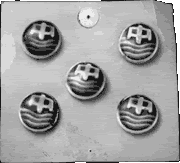
40Hiroka Nishimoto
(then, 12)
41/ Porcelain buttons
Near Dobashi, Koami-cho, 900 m from the hypocenter
Donated by Oyuki Nishimoto
Hiroka Nishimoto (then, 12) was a first-year student at Hiroshima Municipal Junior High School when he was exposed at his building demolition worksite. His mother, Oyuki, walked the city day after day searching for Hiroka. She never found his body, but she found these buttons from the clothing he was wearing that day. The buttons were the only part of his clothing that remained.
The fact that no body parts could be found but only buttons attests to the size of the blast that is achieved in a nuclear explosion.
Videos that show the power of the blast in the WTC attacks
Look how this steel is bent!
VIDEO: Bent steel columns in 9/11 Dailymotion | Vid.me
The only filing cabinet found
VIDEO: The only filing cabinet found Dailymotion | Youtube | Vid.me
There should have been hundreds of filing cabinets at the site.
“Haven’t seen a doorknob …”
VIDEO: Haven’t seen a doorknob Dailymotion | Youtube | Vid.me Photobucket video
Even something the size of a doorknob was hardly seen.
Bent like a horseshoe
VIDEO: Bent like a horseshoe Dailymotion | Youtube video | Vid.me | Photobucket video
The force that bent the steel beam into a horseshoe shape without causing any cracks must have been powerful.
VAPORIZATION
From: “America’s Reaction to the Atomic Bomb”
“Any object within a two kilometer distance from the hypocenter suffered significant burn damage, and those located near the hypocenter were instantaneously vaporized. The Shima hospital, the hypocenter of the atomic bomb was vaporized, along with all her patients.” [Hiroshima]
Vaporization of objects and people is a phenomenon observed in nuclear blasts. In the Hiroshima atomic blast, all the patients in the Shima Hospital, located at the hypocenter of the explosion, vaporized. The two towers, WTC 1 and 2, were at the hypocenter of the explosions. Like Shima Hospital, many people vanished. The remains of 1,116 people have still not been recovered as of 2013 (DailyMirror).
Energy calculation
TNT equivalent is a convention for expressing energy, typically used to describe the energy released in an explosion. The “ton of TNT” is a unit of energy defined by that convention to be 4.184 gigajoules,[1] which is the approximate energy released in the detonation of a metric ton (1,000 kilograms or one megagram) of TNT. The convention intends to compare the destructiveness of an event with that of conventional explosives, of which TNT is a typical example (although other conventional explosives such as dynamite contain more energy). Wikipedia
1 kt is equal to 4.1 x 10^12 joules
The destructive power of a nuclear weapon is expressed in the equivalent size of TNT the detonation of which would produce the same destructive power. 1 kt is the energy contained in the detonation of 1,000 kg of TNT and is the equivalent of 4.1 x 10^12 joules.
Electricity generated by one 20-kg CANDU fuel bundle assuming ~29%[138] thermal efficiency of reactor[139][140]
| Unit | Equivalent to |
| 1 kt | 10^12 calories |
| 4.19×10^12 joules | |
| 4.19×10^19 ergs | |
| 2.62×10^31 eV | |
| 2.62×10^25 MeV | |
| Fission of 0.241 moles of material (1.45×10^23 nuclei) | |
| Fission of approx. 57 g of material | |
| 1.16×10^6 kilowatt-hrs | |
| 3.97×10^9 BTU |
Table from NuclearWeaponArchive
VAPORIZATION
FROM: “America’s Reaction to the Atomic Bomb”
‘Yukiharu did not realize at first that a bomb had exploded. He thought there had been an electrical accident at the plant building he was working in. Then it suddenly became dark and “I heard a huge explosion. The roof of the building had collapsed, and we were under the broken roof. I felt a pain in my head. I managed to escape from the building. I did not know what was happening to us, because we had not experienced any serious bombing. . . . I was not badly hurt. . . . A piece of broken glass was sticking into my head.”‘ [Nagasaki]
Height of pile and amount of debris
In a pancake collapse of a 110-story structure, such as the Twin Towers, you would expect the height of the rubble pile to be much higher. No floors are discernible in the pictures of the collapses. The height of the rubble pile in the picture below is the height that was seen straight after the attacks and before any clearing procedures had started. The small height of the debris indicates that the level of destruction was high and complete for many objects — furniture and similarly sized objects were reduced to small pieces, or even dust particles. Some simply “vaporized”.

Dustification
Nanodust
Some particles were just 0.3 micrometer in size.

Dust particles seen on electron microscopy.
Sample collection of dust of WTC area


From United States Geological Survey – WTC dust analysis:
“Ground sampling consisted of collecting debris from 35 locations in the WTC area, including 33 dust, 2 concrete, and 2 steel beam insulation samples.
Optical photographs of a typical dust sample on the left (sample WTC01-27) and what appeared to be an insulation coating from a steel beam on the right (WTC01-8). The coating contains as much as 20% chrysotile asbestos. Scale bar is 10 millimeters.”
Pictures of dust
The following are pictures of dust coverage in Manhattan the day of September 11. The quantity of dust is very noticeable. It resembles the spread of ash in a volcanic explosion. Similar phenomena are seen in volcanic explosions and nuclear explosions.
In the case of the WTC attacks, the fact that the dust had been produced by nuclear explosions makes the dust highly radioactive. Breathing in this dust would have introduced a significantly high dosage of radiation to the inside of the body, which could cause serious health effects a few years later, such as cancer. Also gamma rays and beta rays can penetrate the skin and produce damage to cells this way.


This man who got caught by the dust storm of the WTC has probably been exposed to a high dose of radioactivity.

Volcanic dust


“Paper and powder” theory of nuclear explosions
“No bodies, furniture or computers found in the rubble, but intact sheets of paper covered the streets with fine dust. Items with significant mass absorbed fusion energy and were vaporized while paper did not. Paper and Powder theory.”


Note the “mud”-spattered car in the background like the car below.



This is thought to be the entrance ramp to the Brooklyn Bridge from southbound FDR Drive. Note the volume of fine dust that covers the street. This sort of scene would be unusual in a pancake collapse.

In the photo above, the location of FDR is marked with red arrows and the WTC towers are outlined in red. The dust traveled from the towers to rest in a thick carpet on the drive.


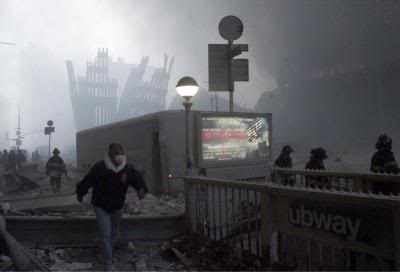




OLYMPUS DIGITAL CAMERA
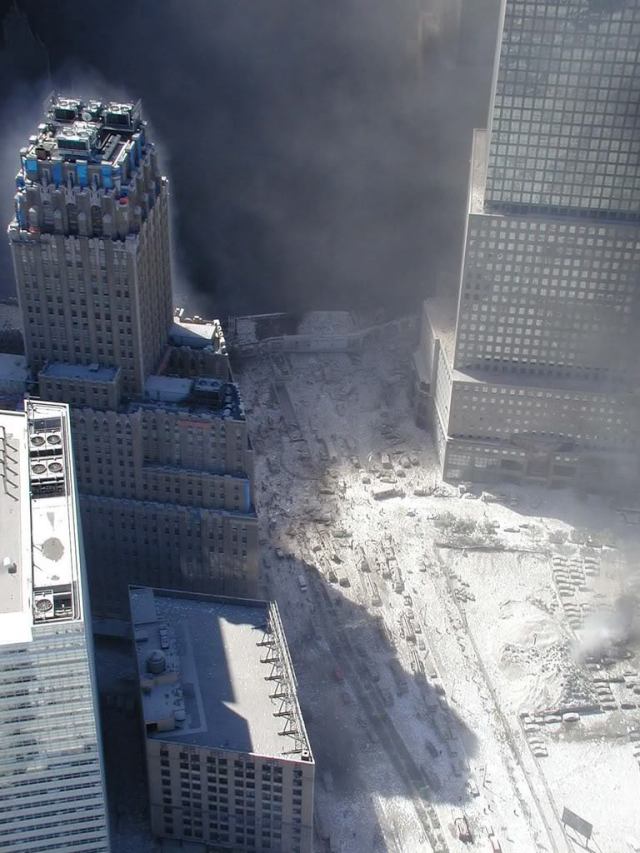
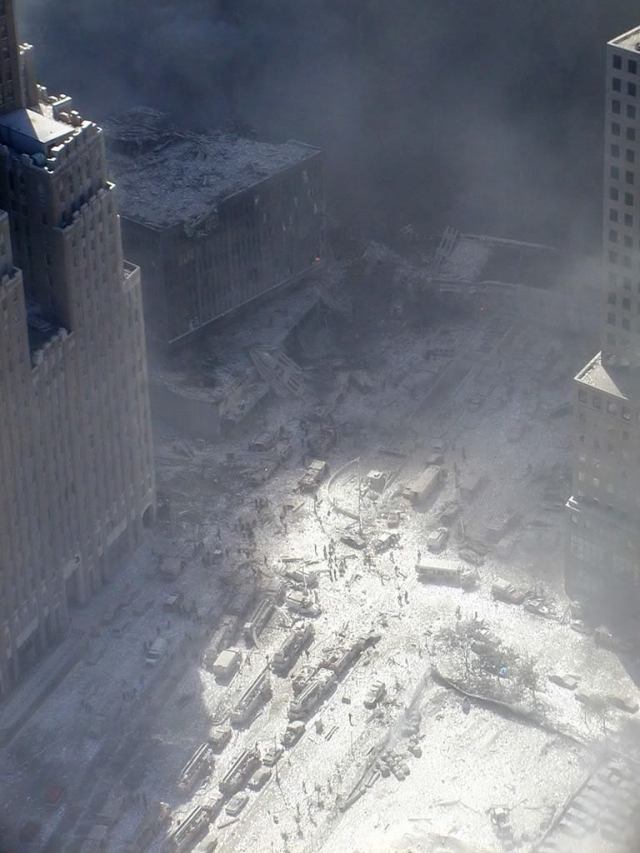





Dust and ash and paper debris was scattered as far as this point (see map).


The beige colored area shows how far the dust has spread. These are the buildings that needed to be cleaned.

The low height of the rubble pile indicates how much of the towers was turned into fine dust.



Paper and powder theory of nuclear explosions – Part 2





IMAGE: Pinatubo volcanoes.usgs.gov
CAPTION: Pumice and ash cover cars and airport runways (Mount Pinatubo, 1991) volcanoes.usgs.gov

IMAGE: tribuneindia.com
CAPTION: A couple removes volcanic ash off their car on Saturday as residents of Miyakejima island, 190 km south of Tokyo, began returning home after they were forced to seek shelter on Friday from volcanic eruption of Mount Oyama on the island, spewing ash as high as 8,000 meters into the air. tribuneindia.com
Transmission spire atop the North Tower aspirating

GIF of the spire aspirating into a spray of dust. Water tank in the foreground. The transmission tower is in the distant background.

Water tank in the foreground. Transmission spire atop WTC 1 is in the background.
Adapted from: drjudywood.com
Video: Transmission tower on top of the North Tower aspirating
VIDEO: North Tower steel core ablating into dust Dailymotion
You can see the transmission tower aspirating. This video also shows the nuclear flash during the explosion. Notice the sudden brightening of the screen as the North Tower explodes.

The base of the transmission tower.








“Dust Lady” Marcy Borders. She died aged 42 of stomach cancer in 2015.


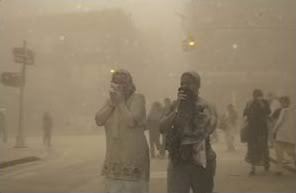


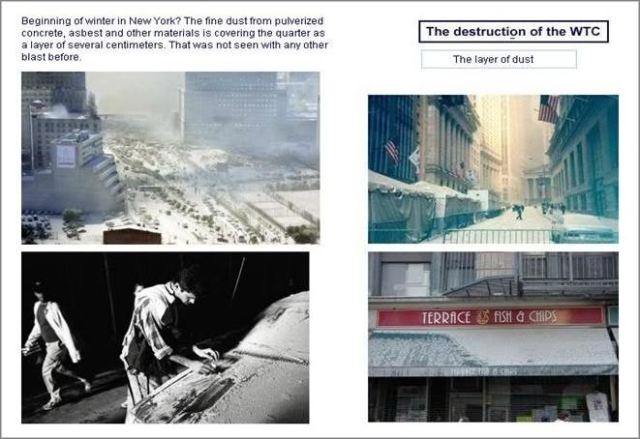





Did the people of Pompeii flee like these people from the engulfing volcanic lava and ash raining down on them?





Dust-covered Ground Zero


Shows dust

Caption: People entering the city for rescue and relief
Approx. 1,180m from the hypocenter, Yamaguchi-cho (now, Kanayama-cho)
This panoramic shot extends from the burnt plain of the city to the west side of Hiroshima Higashi Police Station. People are heading toward the city center along the burnt-out streetcar street to join rescue efforts or search for loved ones pcf.city.hiroshima.jp





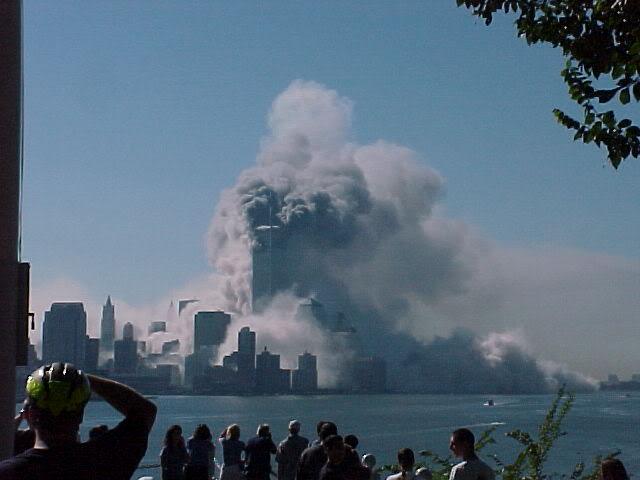





Dust composition
Chemical Analysis – fibers in the aerosol





Analysis of the WTC dust






Dust and smoke samples (3):
Be, Cr, Co, Ga, Rb, Sr, Cd, Cs, Ba, U, Bi are all either radioactive elements found in the decay chain of uranium or are found in nuclear weapons components.

Concentrations of elements in 3 dust and smoke samples (ng/g)
Concentrations of pesticides, PCBs and selected PAHs in 3 dust and smoke samples
Samples were from Cortlandt Street, Cherry Street and Market Street
Total chlordanes were .0031, .0056 and .0037 mg/kg
Total PAHs (40 compounds) were 383.3, 218.1, and 376.1 mg/kg for the three areas
Total PCBs were 0.562 and 0.589 mg/kg

Concentrations of pesticides, PCBs and PAHs in three dust and smoke samples
Concentrations of PAHCs in soils of three urban areas in the US
Total carcinogenic PAHC=8.973mg/kg
Total PAHC=18.361 mg/kg

This study shows background levels of PAHCs in soil of several US cities rsdynamics.com





Leachate analyzed
Radioactive elements found in leachates: beryllium, bismuth, niobium, yttrium, strontium, uranium, gallium (component of weapon), cadmium, cobalt, zirconium, selenium, rubidium, barium, antimony, molybdenum. These can be found in the decay chain of uranium, an element used in nuclear weapons manufacture.
Uranium concentration varied from 5 to 500 ppm

Naturally occurring uranium in environment
Concentration varied from 0.2 to 3.3 ppm

A map showing radioactive uranium concentrations throughout North America. The white areas represent areas not yet mapped. Credit: USGS thoughtco.com
Chemical analysis of WTC dust and girder coating
Uranium concentration ranged from 1 to 10 ppm

Background uranium concentration in ground water in Pennsylvania
Median value of uranium is <0.4 microgram/liter, maximum value is 97 and minimum is <.01

WTC study of dust
Uranium concentration in girder dust, indoor dust and outdoor dust
- minimum 1.96 ppm
- maximum 7.57 ppm
- average 3.29 ppm
“CHAPTER 7. POLYCYCLIC AROMATIC HYDROCARBONS IN AMBIENT AIR AND CANCER”
A meta-analysis of occupational cohort studies found a 20% increase in relative risk per 100 μg/m3 years cumulative B[a]P exposure.
The relative risk of a 20% increase means 120% increase in the cancer rate in individuals exposed to 100ug/m3 years cumulative benzo[a]pyrene, a known human carcinogen.
Other links
Human exposure to natural uranium http://oem.bmj.com/content/oemed/29/1/81.full.pdf
Study of Worker’s Exposure to Thorium, Uranium and Niobium Mineral Dust https://link.springer.com/article/10.1023/A%3A1015599406550?no-access=true
Background Concentrations of Trace and Major Elements in California Soils http://www.swrcb.ca.gov/water_issues/programs/compost/docs/kearney1996.pdf
Task 6: Radiation Doses and Risk to Residents from FMPC Operations from 1951-1988 Volume I The Fernald Dosimetry Reconstruction Project https://www.cdc.gov/nceh/radiation/fernald/fernald_dose__reconstruct_task/task-6_-killough.final-report.pdf
Natural radioactivity http://www.physics.isu.edu/radinf/natural.htm
Toxicological profile for uranium https://www.atsdr.cdc.gov/toxprofiles/tp150-c6.pdf
Natural background radiation in Jordan http://www.iaea.org/inis/collection/NCLCollectionStore/_Public/29/009/29009828.pdf
Natural radioactivity and radiation https://www.ncbi.nlm.nih.gov/books/NBK230654/table/ttt00006/?report=objectonly
A review on natural background radiation https://www.ncbi.nlm.nih.gov/pmc/articles/PMC3814895/
Environmental radiation http://hps.org/documents/environmental_radiation_fact_sheet.pdf
Polycyclic aromatic hydrocarbons (PAH) and polychlorinated biphenyls (PCB) in urban soils of Greater London, UK http://www.sciencedirect.com/science/article/pii/S0883292714002248
Polycyclic Aromatic Hydrocarbons and Polychlorinated Biphenyls in Topsoils of Harbin, China https://link.springer.com/article/10.1007/s00244-009-9314-y
Summary of the argument for controlled demolition
Architects & Engineers for 9/11 Truth
 |
|
| As seen in this revealing photo the Twin Towers’ destruction exhibited all the characteristics of destruction by explosions: | |
| 1. | Extremely rapid onset of “collapse” |
| 2. | Sounds of explosions at plane impact zone — a full second prior to collapse (heard by 118 first responders as well as by media reporters) |
| 3. | Observations of flashes (seen by numerous professionals) |
| 4. | Squibs, or “mistimed” explosions, 40 floors below the “collapsing” building seen in all the videos |
| 5. | Mid-air pulverization of all the 90,000 tons of concrete and steel decking, filing cabinets & 1000 people – mostly to dust |
| 6. | Massive volume of expanding pyroclastic dust clouds |
| 7. | Vertical progression of full building perimeter demolition waves |
| 8. | Symmetrical collapse – through the path of greatestno resistance resistance – at free-fall speed — the columns gave |
| 9. | 1,400 foot diameter field of equally distributed debris – outside of building footprint |
| 10. | Blast waves blew out windows in buildings 400 feet away |
| 11. | Lateral ejection of thousands of individual 20 – 50 ton steel beams up to 500 feet |
| 12. | Total destruction of the building down to individual structural steel elements – obliterating the steel core structure. |
| 13. | Tons of molten metal found by FDNY under all 3 high-rises |
| 14. | FEMA finds rapid oxidation and intergranular melting on structural steel samples |
| 15. | More than 1000 Bodies are unaccounted for — 700 tiny bone fragments found on top of nearby buildings |
| And exhibited none of the characteristics of destruction by fire, i.e. | |
| 1. | Slow onset with large visible deformations |
| 2. | Asymmetrical collapse which follows the path of least resistance (laws of conservation of momentum would cause a falling, intact, from the point of plane impact, to the side most damaged by the fires) |
| 3. | Evidence of fire temperatures capable of softening steel |
| 4. | High-rise buildings with much larger, hotter, and longer lasting fires have never “collapse |
WTC Dust Analysis Results
 Tar Fragments Tar FragmentsPhoto 1 (above): Dust covered everything at and around Ground Zero. |
| WTC Dust Analysis Results |
| Construction Debris – Plaster – Carbonate fragments – Mica/vermiculite – Glass Fibers – Chemically processed cellulose fibers |
| Quartz Grains |
| Low-Temperature Combustion Materials – Includes charred wood fragments |
| Hair |
| Chrysotile Asbestos Fibers – Some with adhering carbonate binder, total estimated to comprise <1% |
| Synthetic Fibers |
| Cellulose Fibers – Cotton and paper |
| Insect Parts |
Evidence of advanced fusion devices at the WTC:1. Pulverization of 99% of concrete into ultra fine dust as recorded by official studies. Concrete dust was created instantly throughout the towers when the fusion device million degree heat rapidly expanded water vapour 1000-fold in the concrete floors. 2. Superheated steels ablating (vaporizing continuously as they fall) as seen in video clips of the towers collapsing. This requires uniform temperatures roughly twice that of thermite. Conventional demolition or explosive charges (thermate, rdx, hdx etc.) cannot transfer heath so rapidly that the steel goes above it’s boiling temperature. 3. 22 ton outer wall steel sections ejected 200 meters into the winter garden. Cutting charges cannot eject heavy steels and throwing charges cannot provide the energy required without heavy, solid surface mounts.
4. 330 ton section of outer wall columns ripping off side of tower. Cutting charges cannot eject heavy steels linked together and throwing charges cannot provide the energy required without very heavy, solid surfaces to mount those charges.
5. Molten ponds of steel at the bottom of elevator shafts (WTC1, WTC2, WTC7). Massive heath loads have been present at the lower parts of these high-rise buildings. As one of the witnesses after seeing the flow of metals declared: “no one will be found alive”. 6. The spire behaviour (stands for 20-30 seconds, evaporates and goes down, steel dust remains in the air where the spire was). The spire did not stand because it lost its durability when the joints vaporized. 7. Sharp spikes in seismograph readings (Richter 2.1 and 2.3) occurred at the beginning of collapse for both towers. Short duration and high power indicate an explosive event. 8. A press weighting 50 tons disappeared from a basement floor of Twin Towers and was never recovered from debris. Not possible with collapses or controlled demolitions. The press was vaporized or melted totally.
Caption: Not the same press as the WTC one cmc.cheme.cmu.edu 9. Bone dust cloud around the WTC. This was found not until spring 2006 from the Deutsche Bank building. (In excess of 700 human remains found on the roof and from air vents). See 911citizenswatch.org 10. Fires took 100 days to extinguish despite continuous spraying of water. Thermate would burn out totally and then cool down much faster, just in a few days. This long cooling time means the total heath load being absorbed into the steels of the WTC was massive, far in excess anything found in collapses or typical controlled demolitions. 11. Brown shades of color in the air due nuclear radiation forming NO2, NO3 and nitric acid. TV and documentary footage changed the color balance to blue to disguise this fact indicating complicity in the coverup 12. Elevated Tritium values measured in the WTC area but not elsewhere in New York. Official studies stated that 8 EXIT signs from two commercial Boeing jets were responsible. The tritium in those EXIT signs is insufficient to explain the measurements (very little tritium is available for measuring after evaporation into air as hydrogen and as tritiated water vapour. This can provide conclusive proof of fusion devices and therefore US/Israeli military involvement. 13. Pyroclastic flow observed in the concrete-based clouds. Only found with volcanic eruptions and nuclear detonations. The explosion squibs cool down just a few milliseconds after the explosion or after having reached some 10 meters in the air. Pyroclastic flow will not mix with other clouds meaning very serious heath in those clouds not possible with the conventional demolition or explosive charges. The pyroclastic clouds were cooling down at the WTC but this process took some 30 seconds. See video.google.com 14. Huge expanding dust clouds 5 times the volume of the building indicating extreme levels of heat generated far in excess of traditional demolition explosives. 15. Rubble height was some 10% of the original instead of 33% expected in a traditional demolition. Fusion device removal of underground central steel framework allowed upper framework to fall into this empty space and reduce the rubble height. 16. No survivors found, except some firefighters in one corner pocket in the rubble who looked up to see blue sky above them instead of being crushed by collapsing debris. Upward fusion flashlight-like beam of destruction missed this pocket but removed debris above those lucky firemen. 17. 14 rescue dogs and some rescue workers died far too soon afterward to be attributed to asbestos or dust toxins (respiratory problems due to alpha and tritium particles created by fusion are far more toxic) 18. Record concentrations of near-atomic size metal particles found in dust studies due to ablated steel. Only possible with vaporized (boiling) steels. 19. Decontamination procedure used at Ground Zero (hi-pressure water spraying) for all steel removed from site. Water spraying contains fusion radioactivity. 20. No bodies, furniture or computers found in the rubble, but intact sheets of paper covered the streets with fine dust. Items with significant mass absorbed fusion energy (neutrons, x-rays) and were vaporized while paper did not. Paper and powder theory. Paper and powder theory
21. 200 000 gallon sprinkler water tanks on the roofs of WTC1 and WTC2, but no water in the ruins. Heat of fusion devices vaporized large reservoirs of water. 22. Reports of cars exploding around the WTC and many burned out wrecks could be seen that had not been hit by debris. Fusion energy (heath radiation and the neutrons) caused cars to ignite and burn far from WTC site. 23. Wide area electrical outage, repairs took over 3 months. Fusion devices cause EM pulse with Compton scattering. See German engineers help the USA plate 5. home.debitel.net 24. EM pulse was recorded by broadcast cameras with high quality electronic circuitry. This occurred at the same time as the seismic peaks recorded by Lamont Doherty during the beginning of the collapse. This is due to the Compton Effect and resulted in a large area power outage at the WTC. |
“Paper and powder” video: from 9/11 Eyewitness
VIDEO: Paper and powder theory Dailymotion

Image from the video: “We see white sheets of paper floating on a cushion of air”

Image from video: “Paper and powder. How could it be possible? It appears that the high strength to weight ratio of paper allowed it to survive the energy blast that vaporized all heavy and denser materials.”
______________________________________________________________








